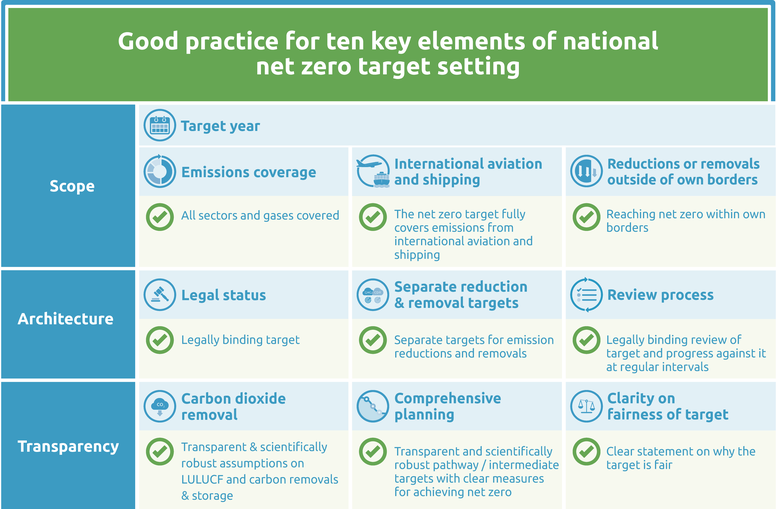Net zero targets
Summary
We evaluate the net zero target as: Target information incomplete.
President Biden announced the ‘Biden Plan’ during the election campaign in 2020, proposing net zero emissions for the US by 2050, which we interpret as covering all GHGs. Although the target has not been legislated, the net zero emissions goal is repeatedly mentioned in executive orders, which have the force of law, that refer to the implementation of policies or strategies that are consistent with this goal. The target was also mentioned in the official US submission of its Nationally Determined Contribution (NDC), and other national plans, including the proposed infrastructure plan (“American Jobs Plan”).
Besides the net zero target by 2050, the administration also pledges to fully decarbonise the power sector by 2035 and to reduce building stock’s emissions by 50% by 2035 (J. Biden, 2020).
The CAT currently cannot evaluate the proposal given the preliminary nature and a lack of more detailed information. The US would need more concrete measures passed through legislation for it to be implemented because executive orders, while they have the force of law, can be easily undone by the next administrations. The CAT will evaluate the net zero target once the administration communicates further information.
Ten key elements
Scope
- Target year – The ‘Biden Plan’ proposes to reach net zero emissions by 2050 (The White House, 2021b).
- Emissions coverage – While information remains incomplete, the CAT assumes that the proposed net zero target covers all GHG emissions and all sectors of the economy (CAT, 2020).
- International aviation and shipping – International aviation and shipping are mentioned in the same policy documents, for example the January Executive Order, but their exact relation to the target of net zero by 2050 is unclear.
- Reductions or removals outside of own borders – The US provides no information on its intention to use international offset credits to meet its net zero target.
Target architecture
- Legal status – The net zero target was initially proposed under the ‘Biden Plan’ but remains under discussion in the US after President Biden took office in January 2021. As of June 2021, the net zero target has been mentioned in executive orders, though the target would be much more robust with additional implementation measures and if it were to be passed by the US Congress and signed by the President. Under the Obama Administration, the US submitted an LTS to the UNFCCC in 2016. However, as of August 2021 the US has not submitted a long-term strategy to the UNFCCC reflecting the net-zero goal by 2050.
- Separate reduction & removal targets – The US provides no information on its intention to communicate separate emission reduction and removal targets.
- Review process – The US provides no information on its intention to establish a review cycle for its net zero and intermediate targets.
Transparency
- Carbon dioxide removal – The US provides no information on its intention to communicate transparent assumptions on carbon dioxide removals.
- Comprehensive planning – The ‘Biden Plan’ lacks specific emission pathways on how to reach net zero emissions. The plan includes a pledge to fully eliminate carbon pollution from power plants by 2035 and to reduce building stock’s emissions by 50% by 2035 (J. J. Biden & Sanders, 2020). Further information on interim GHG emission reduction targets, specific milestones, and explicit policies to achieve the target remains missing as of August 2021.
- Clarity on fairness of target – The US provides no information on its intention to explain the target’s fairness.
Good practice
The Climate Action Tracker has defined the following good practice for all ten key elements of net zero targets. Countries can refer to this good practice to design or enhance their net zero targets.
Further analysis
Latest publications
Stay informed
Subscribe to our newsletter





